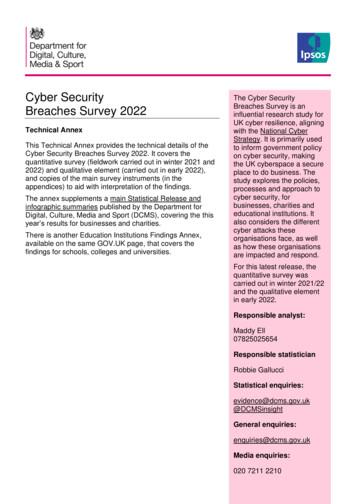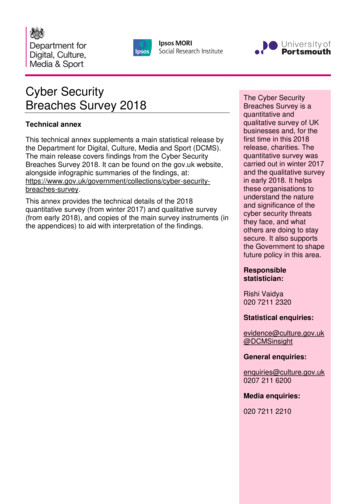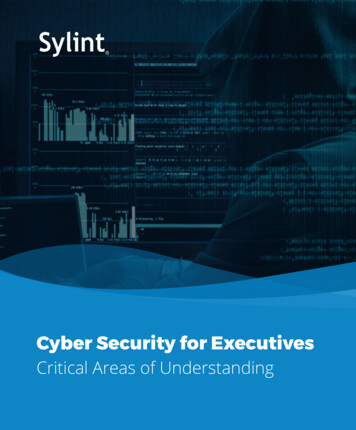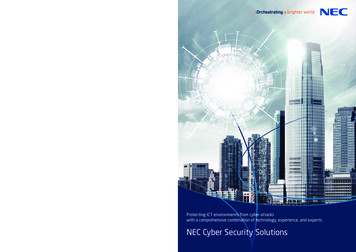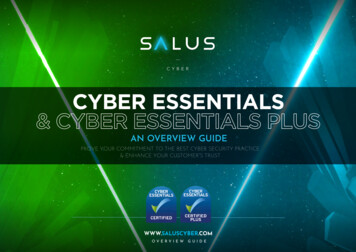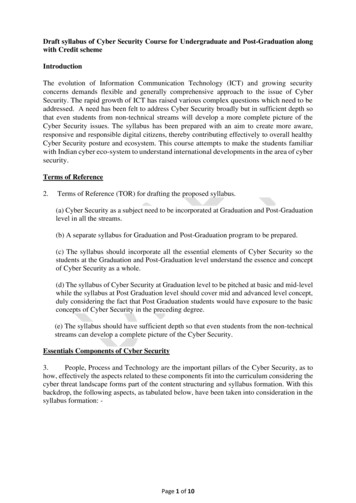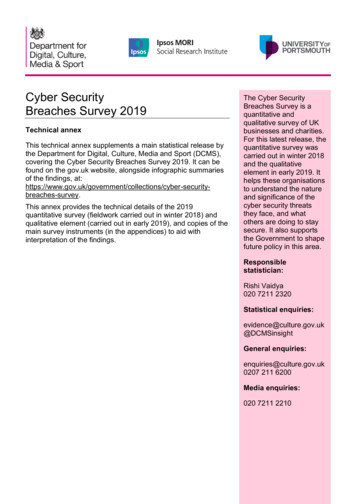
Transcription
Cyber SecurityBreaches Survey 2019Technical annexThis technical annex supplements a main statistical release bythe Department for Digital, Culture, Media and Sport (DCMS),covering the Cyber Security Breaches Survey 2019. It can befound on the gov.uk website, alongside infographic summariesof the findings, -securitybreaches-survey.This annex provides the technical details of the 2019quantitative survey (fieldwork carried out in winter 2018) andqualitative element (carried out in early 2019), and copies of themain survey instruments (in the appendices) to aid withinterpretation of the findings.The Cyber SecurityBreaches Survey is aquantitative andqualitative survey of UKbusinesses and charities.For this latest release, thequantitative survey wascarried out in winter 2018and the qualitativeelement in early 2019. Ithelps these organisationsto understand the natureand significance of thecyber security threatsthey face, and whatothers are doing to staysecure. It also supportsthe Government to shapefuture policy in this area.Responsiblestatistician:Rishi Vaidya020 7211 2320Statistical al enquiries:enquiries@culture.gov.uk0207 211 6200Media enquiries:020 7211 2210
Department for Digital, Culture, Media and SportCyber Security Breaches Survey 2019: Technical AnnexContentsChapter 1:Chapter 2:Chapter 3:Appendix A:Appendix B:Appendix C:Appendix D:Appendix E:Overview . 11.1 Summary of methodology . 11.2 Strengths and limitations of the survey . 11.3 Changes from previous waves . 21.4 Comparability to the earlier Information Security Breaches Surveys . 2Survey approach technical details . 32.1 Survey and questionnaire development. 32.2 Survey microsite . 52.3 Sampling. 52.4 Fieldwork . 102.5 Fieldwork outcomes and response rate . 122.6 Data processing and weighting . 132.7 Points of clarification on the data . 17Qualitative approach technical details. 181.1 Sampling. 181.2 Recruitment quotas and screening . 181.3 Fieldwork . 183.2 Analysis . 20Pre-interview questions sheet . 21Interviewer glossary . 22Questionnaire . 25Topic guide . 61Further information. 68
Department for Digital, Culture, Media and SportCyber Security Breaches Survey 2019: Technical Annex1Chapter 1: Overview1.1 Summary of methodologyThe Cyber Security Breaches Survey 2019 comprised: a quantitative random probability telephone survey of 1,566 UK businesses and 514 UKregistered charities, carried out from 10 October 2018 to 20 December 2018 52 qualitative in-depth interviews, undertaken in January and February 2019 to follow upwith organisations that participated in the quantitative survey.1.2 Strengths and limitations of the surveyWhile there have been other surveys about cyber security in organisations in recent years,these have often been less applicable to the typical UK business or charity for severalmethodological reasons, including: focusing on larger organisations employing cyber security or IT professionals, at theexpense of small organisations (with under 50 staff) that make up the overwhelmingmajority, and may not employ a professional in this role covering several countries alongside the UK, which leads to a small sample size of UKorganisations using partially representative sampling or online-only data collection methods.By contrast, the Cyber Security Breaches Survey series is intended to be statisticallyrepresentative of UK businesses of all sizes and all relevant sectors, and of UK registeredcharities in all income bands.The 2019 survey shares the same strengths as previous surveys in the series: the use of random-probability sampling to avoid selection bias the inclusion of micro and small businesses, and low-income charities, which ensures thatthe respective findings are not skewed towards larger organisations a telephone data collection approach, which aims to also include businesses and charitieswith less of an online presence (compared to online surveys) a comprehensive attempt to obtain accurate spending and cost data from respondents, byusing a pre-interview questions sheet and microsite, and giving respondents flexibility inhow they can answer (e.g. allowing numeric and banded amounts, as well as answersgiven as percentages of turnover or IT spending) a consideration of the cost of cyber security breaches beyond the immediate time-cost(e.g. explicitly asking respondents to consider their direct costs, recovery costs and longterm costs, while giving a description of what might be included within each of thesecosts).At the same time, while this survey aims to produce the most representative, accurate andreliable data possible with the resources available, it should be acknowledged that there areinevitable limitations of the data, as with any survey project. The following might be consideredthe two main limitations: Organisations can only tell us about the cyber security breaches or attacks that they havedetected. There may be other breaches or attacks affecting organisations, but which arenot identified as such by their systems or by staff, such as a virus or other malicious code
Department for Digital, Culture, Media and SportCyber Security Breaches Survey 2019: Technical Annex2that has so far gone unnoticed. Therefore, the survey may have a tendency tosystematically underestimate the real level of breaches or attacks. When it comes to estimates of spending and costs associated with cyber security, thissurvey still ultimately depends on self-reported figures from organisations. As previousyears’ findings suggest, most organisations do not actively monitor the financial cost ofcyber security breaches. Moreover, as above, organisations cannot tell us about the costof any undetected breaches or attacks. Again, this implies that respondents mayunderestimate the total cost of all breaches or attacks (including undetected ones).1.3 Changes from previous wavesOne of the objectives of the survey is to understand how approaches to cyber security and thecost of breaches are evolving over time. Therefore, the survey methodology is intended to be ascomparable as possible to the 2016, 2017 and 2018 surveys.A small number of questions from the 2016, 2017 and 2018 quantitative surveys were deletedor changed in 2019 to make way for new questions. The changes reflected DCMS priorities,and aimed to improve the survey. Section 2.1 summarises these changes. In the main report,we only make comparisons to 2016, 2017 and 2018 findings where these are valid (i.e. wherequestions were asked consistently).1.4 Comparability to the earlier Information Security Breaches SurveysFrom 2012 to 2015, the Government commissioned and published annual Information SecurityBreaches Surveys. While these surveys covered similar topics to the Cyber Security BreachesSurvey series, they employed a radically different methodology, with a self-selecting onlinesample weighted more towards large businesses. Moreover, the question wording and order isdifferent for both sets of surveys. This means that comparisons between surveys from bothseries are not possible.
Department for Digital, Culture, Media and SportCyber Security Breaches Survey 2019: Technical Annex3Chapter 2: Survey approach technical details2.1 Survey and questionnaire developmentIpsos MORI developed the questionnaire and all other survey instruments (e.g. the interviewscript and respondent microsite), which DCMS then approved. Development for this year’ssurvey took place over three stages from July to September 2018: stakeholder conversations with the Association of British Insurers (ABI), the Confederationof British Industry (CBI), the Federation of Small Businesses (FSB) and the Institute ofChartered Accountants in England and Wales (ICAEW). cognitive testing interviews with four businesses and four charities a pilot survey, consisting of 19 interviews with businesses and 21 with charities.Stakeholder conversationsThe stakeholder conversations were intended to: clarify the key cyber security issues facing organisations, including any new issues arisingsince the 2018 survey review the 2018 questionnaire, survey instruments and findings, to assess gaps inknowledge and new question areas to be included in 2019.Before this stage, the DCMS team had already liaised with various Government stakeholdersabout the survey. Based on these discussions and their own internal thinking, DCMS decided tokeep as much of the survey as consistent as possible with previous years, with only a smallnumber of specific questionnaire changes and improvements made for this year.Given that DCMS anticipated very few changes to the questionnaire this year, the moreintensive stakeholder workshops and in-depth interviews carried out in previous years were notneeded. Instead, Ipsos MORI gathered feedback from representatives of the ABI, CBI, the FSB,ICAEW and our research partners, the Institute of Criminal Justice Studies (ICJS), throughemails and telephone conversations.Following this stage, we amended the 2018 questionnaire with provisional new questions fortesting, guided by DCMS. The changes were minor and were as follows: We added new questions to explore:o when cyber security policies were last reviewedo two-factor authentication (a late addition, which we were not able to cognitively test andhas not been included in the main report – see Section 3.4)o awareness of the implications of GDPR. We amended the wording of RULES around personal data encryption to make clearerwhat was being asked. To allow space for new questions, we deleted four questions from 2018. This was eitherbecause they had been of limited use in previous years, or because DCMS felt theycovered the same ground as other questions in the survey.o CHARITYO was a question splitting the charity sample into subgroups by charitablearea. This information was not used in reporting last year due to low subgroup samplesizes, so was removed on that basis.o CORE was similar to ONLINE (both covered organisations’ online exposure).o DOC overlapped with MANAGE and IDENT (covering documentation of cyber risks).o CONTING was similar to INCID (covering incident response plans).
Department for Digital, Culture, Media and SportCyber Security Breaches Survey 2019: Technical Annex4 We amended the survey and microsite introductions, and recontact question wording.These were made shorter, to better encourage participation. We also added the necessarytext and an upfront screener question to gain explicit consent from respondents, in linewith General Data Protection Regulation (GDPR) requirements.Cognitive testingThe Ipsos MORI research team carried out eight cognitive testing interviews to testcomprehension of new questions for 2019, and also to review the survey introduction and thenew encouragements for taking part (the offer of a Government guidance help card and anelectronic copy of the survey findings).We recruited all participants by telephone. We purchased the business sample from the Dun &Bradstreet business directory, and took a random selection of charities from the charityregulator databases in each UK country. We applied recruitment quotas and offered 50incentive1 to ensure different-sized organisations from a range of sectors or charitable areastook part.After this stage, the questionnaire was tweaked. The changes were very minor. We updated the answer scale for REVIEW. We chose between alternative versions of the new GDPR-related questions (the onesrelating to fines and reporting of breaches to the Information Commissioner’s Office). Weremoved the ones that had a definitely true–definitely false scale (where the correctanswers were easy for participants to guess).Pilot surveyThe pilot survey was used to: test the questionnaire CATI (computer-assisted telephone interviewing) scripttime the questionnairetest the usefulness of the written interviewer instructions and glossaryexplore likely responses to questions with an “other WRITE IN” option (where respondentscan give an answer that is not part of the existing pre-coded list) test the quality and eligibility of the sample (by calculating the proportion of the dialledsample that ended up containing usable leads).Ipsos MORI interviewers carried out all the pilot fieldwork between 24 and 28 September 2018.Again, we applied quotas to ensure the pilot covered different-sized businesses from a range ofsectors, and charities with difference incomes and from different countries. We carried out with19 interviews with businesses and 21 with charities (40 in total).The pilot sample came from the same sample frames used for the main stage survey forbusinesses and charities (see next section). In total, we randomly selected 320 business leadsand 290 charity leads.Not all these leads were used to complete the 40 pilot interviews. In the end, 117 untouchedbusiness leads and 4 charity leads from the pilot were released again for use in the main stagesurvey.The questionnaire length for the pilot was 22 minutes, which was on target for the main stage.Following feedback from the pilot survey, we made some minor changes to the questionnaire: further shortening the introduction1This was administered either as a cheque to the participant or as a charity donation, as the participant preferred.
Department for Digital, Culture, Media and SportCyber Security Breaches Survey 2019: Technical Annex5 grouping the pre-coded responses into categories at NOINSURE for easier responseallocation adding “Charity Commission” as an answer code at REPORTB.Appendix C includes a copy of the final questionnaire used in the main survey.2.2 Survey micrositeAs in previous years, a publicly accessible microsite2 (still active as of April 2019) was againused to: provide reassurance that the survey was legitimatepromote the survey endorsementsprovide more information before respondents agreed to take partallow respondents to prepare spending and cost data for the survey before taking partallow respondents to give more accurate spending and cost data during the interview, bylaying out these questions on the screen, including examples of what came under eachtype of cost (e.g. “staff not being able to work” being part of the direct costs of a breach).The survey questionnaire included a specific question where interviewers asked respondents ifthey would like to use the microsite to make it easier for them to answer certain questions. Atthe relevant questions, respondents who said yes were then referred to the appropriate page orsection of the microsite, while others answered the questionnaire in the usual way (with theinterviewer reading out the whole question).2.3 SamplingBusiness population and sample frameThe target population of businesses matched those included in the 2018, 2017 and 2016surveys: private companies or non-profit organisations3 with more than one person on the payroll universities and independent schools or colleges.4The survey is designed to represent enterprises (i.e. the whole organisation) rather thanestablishments (i.e. local or regional offices or sites). This reflects that multi-site organisationswill typically have connected IT devices and will therefore deal with cyber security centrally.The sample frame for businesses was the Government’s Inter-Departmental Business Register(IDBR), which covers businesses in all sectors across the UK at the enterprise level. This is oneof the main sample frames for Government surveys of businesses and for compiling officialstatistics.Review of alternative sampling framesAt the development stage this year, Ipsos MORI carried out a review of sampling approaches toensure the sampling frame being used for the survey remained fit for purpose. We reviewedSee https://csbs.ipsos-mori.com/ for the Cyber Security Breaches Survey microsite (active as of publication of thisstatistical release).2These are organisations that work for a social purpose, but are not registered as charities, so not regulated bytheir respective Charity Commission.3These are typically under SIC 2007 category P. Where these organisations identified themselves to be charities,they were moved to the charity sample.4
Department for Digital, Culture, Media and SportCyber Security Breaches Survey 2019: Technical Annex6several alternative potential sample frames, including the following commercial businessdatabases: Dun & Bradstreet Experian Market Location.These commercial sample frames have some advantages over the IDBR. For example: With the IDBR, businesses selected in the micro category (with 1 to 9 staff) havesometimes turned out to be sole traders (with 0 staff), who are not eligible for this survey.This accounted for 1 per cent of the sample in 2019 and 2 per cent in 2018. Commercialsample frames typically produce samples with a higher eligibility rate, because they tendto have fewer businesses misclassified as sole traders. A high majority of records come with a switchboard number for the business, as well as akey decision-maker contact name. This contrasts with the low telephone coverage for theIDBR (13% of the selected IDBR sample had telephone numbers this year). TheHowever, there were downsides to the commercial sampling frames too. For example: The commercial sample frames have far fewer records overall than the IDBR, ranging fromc.700,000 to c.1 million, compared to c.2 million for the IDBR. A survey sample achievedfrom any of these sample frames can be weighted on observable variables, such as sizeand sector, to match the overall business population profile. However, we cannot weight tocorrect for non-observable differences between the types of businesses in each frame.Therefore, the representativeness of a sample achieved through a commercial frame maybe called into question when compared to surveys using the IDBR. The IDBR is compiled in a transparent and very consistent way each year. The waycommercial frames are compiled is less transparent and, hence, potentially subject tounknown changes each year. With a commercial frame, therefore, users may not have thesame level of confidence in the survey tracking legitimate changes in attitudes orbehaviours over time. Any unusual changes in results might simply reflect changes in thetypes of businesses represented in the sample frame for that particular year.Consequently, following this review, we agreed with DCMS that it was best to continue to usethe IDBR in this year’s survey.Exclusions from the IDBR sampleWith the exception of universities, public sector organisations are typically subject toGovernment-set minimum standards on cyber security. Moreover, the focus of the survey wasto provide evidence on businesses’ engagement, to inform future policy for this audience. Publicsector organisations (Standard Industrial Classification, or SIC, 2007 category O) weretherefore considered outside of the scope of the survey and excluded from the sampleselection.As in all previous years, organisations in the agriculture, forestry and fishing sectors (SIC 2007category A) were also excluded. There are practical considerations that make it challenging tointerview organisations in this relatively small sector, as this requires additional authorisationfrom the Department for Environment, Food and Rural Affairs if sampling from the IDBR. Wealso judged cyber security to be a less relevant topic for these organisations, given their relativelack of e-commerce.
Department for Digital, Culture, Media and SportCyber Security Breaches Survey 2019: Technical Annex7Charity population and sample frames (including limitations)The target population of charities was all UK registered charities. The sample frames were thecharity regulator databases in each UK country: the Charity Commission for England and Wales ult.aspx the Office of the Scottish Charity Regulator database: register/charity-register-download the Charity Commission for Northern Ireland arity-search/.In England and Wales, and in Scotland, the respective charity regulator databases contain acomprehensive list of registered charities. The Charity Commission in Northern Ireland does notyet have a comprehensive list of established charities. It is in the process of registering charitiesand building one. Alternative sample frames for Northern Ireland, such as the Experian and Dun& Bradstreet business directories (which also include charities) were considered, and ruled out,because they did not contain essential information on charity income for sampling, and cannotguarantee up-to-date charity information.Therefore, while the Charity Commission in Northern Ireland database was the best sampleframe for this survey, it cannot be considered as a truly random sample of Northern Irelandcharities at present. This situation appears, however, to have slightly improved since the 2018survey (the first to include charities); in 2019, there were 6,078 registered charities on theNorthern Ireland database, compared to 5,811 in 2018.Sample selectionIn total, 77,432 businesses were selected from the IDBR for the 2019 survey. This is muchhigher than the 53,783 businesses selected for the 2018 survey, and the 27,948 selected in the2017 survey. We chose the higher number to ensure there was enough reserve sample to meetthe size-by-sector survey targets, based on the sample quality of the two previous waves. In the2018 survey, we had used up all reserve sample in the largest size band. There had also beena successive decline in sample quality (in terms of telephone coverage and usable leads) inboth 2017 (vs. 2016) and 2018 (vs. 2017). Ultimately, the 2019 sample quality turned out to beequivalent to the 2018 sample (with a very slightly higher proportion of usable leads), leaving uswith sufficient usable leads because of the higher selection count.The business sample was proportionately stratified by region, and disproportionately stratifiedby size and sector. An entirely proportionately stratified sample would not allow sufficientsubgroup analysis by size and sector. For example, it would effectively exclude all medium andlarge businesses from the selected sample, as they make up a very small proportion of all UKbusinesses. Therefore, we set disproportionate sample targets for micro (1 to 9 staff), small (10to 49 staff), medium (50 to 249 staff) and large (250 or more staff) businesses. We also boostedspecific sectors, to ensure we could report findings for the same sector subgroups that wereused in the 2018 report. The boosted sectors included: educationentertainment; service or membership organisationshealth, social work or social careinformation and communicationstransport and storage.Post-survey weighting corrected for the disproportionate stratification (see section 2.6).Table 2.1 breaks down the selected business sample by size and sector.
Department for Digital, Culture, Media and Sport8Cyber Security Breaches Survey 2019: Technical AnnexTable 2.1: Pre-cleaning selected business sample by size and sectorSIC 2007letter5Sector descriptionMicro orsmall (1–49 staff)Medium(49–249staff)Large(250 staff)TotalB, C, D, EUtilities or production ion8,1371181138,368GRetail or wholesale (includingvehicle sales and repairs)5,9742717346,979HTransport or storage6,1101863446,640IFood or hospitality4,3152331694,717JInformation or communications11,41118038711,978KFinance or insurance1,1002493831,732L, NAdministration or real estate8,1952184478,860MProfessional, scientific 4,555QHealth, social care or social work3,6471991804,026R, SEntertainment, service ormembership 7,432The charity sample was proportionately stratified by country and disproportionately stratified byincome band. This used the same reasoning as for businesses – without this disproportionatestratification, analysis by income band would not be possible as hardly any high-incomecharities would be in the selected sample. As the entirety of the three charity regulatordatabases were used for sample selection, there was no restriction in the amount of charitysample that could be used, so no equivalent to Table 2.1 is shown for charities.Sample telephone tracing and cleaningNot all the original sample was usable. In total, 67,434 original business leads had either notelephone number or an invalid telephone number (i.e. the number was either in an incorrectformat, too long, too short or a free phone number which would charge the respondent whencalled). For Scottish charities, there were no telephone numbers at all on the database. Wecarried out telephone tracing (matching the database to both the UK Changes business andresidential number databases) to fill in the gaps where possible. No telephone tracing wasrequired for charities from England and Wales, and Northern Ireland.The selected sample was also cleaned to remove any duplicate telephone numbers, as well asthe small number of state-funded schools or colleges that were listed as being in the educationsector (SIC 2007 category P) but were actually public-sector organisations.SIC sectors here and in subsequent tables in this report have been combined into the sector groupings used inthe main report.5
Department for Digital, Culture, Media and Sport9Cyber Security Breaches Survey 2019: Technical AnnexAt the same time as this survey, Ipsos MORI was also carrying out two other business surveyswith potentially overlapping samples. These were the Commercial Victimisation Survey 2019 forthe Home Office; and another survey on attitudes to cyber security commissioned by theNational Cyber Security Centre. We therefore removed overlapping sample leads from thissurvey to avoid contacting the same organisations for multiple surveys.Following telephone tracing and cleaning, the usable business sample amounted to 15,358leads (including the leads taken forward from the pilot). For the Scotland charities sample, 3,546leads had telephone numbers after matching.Table 2.2 breaks the usable business leads down by size and sector. As this shows, there wastypically much greater telephone coverage in the medium and large businesses in the sampleframe than among micro and small businesses. This has been a common pattern across years.In part, it reflects the greater stability in the medium and large business population, where firmstend to be older and are less likely to have recently updated their telephone numbers.Table 2.2: Post-cleaning available main stage sample by size and sectorSIC 2007letterSector descriptionB, C, D, EUtilities or production (includingmanufacturing)FGHIJKL, NMPQConstructionRetail or wholesale (includingvehicle sales and repairs)Transport or storageFood or hospitalityInformation or communicationsFinance or insuranceAdministration or real estateProfessional, scientific ortechnicalEducationHealth, social care or social workMicro orsmall (1–49 staff)Medium(49–249staff)Large(250 3711710275612%85%86%17%524182157863
Department for Digital, Culture, Media and Sport10Cyber Security Breaches Survey 2019: Technical AnnexSIC 2007letterSector descriptionR, SEntertainment, service ormembership organisationsTotalMicro orsmall (1–49 staff)Medium(49–249staff)Large(250 882,0823,08815,35814%86%76%20%The usable leads for the main stage survey were randomly allocated into separate batches forbusinesses and charities. The first business batch included 5,451 leads proportionately selectedto incorporate sample targets by sector and size band, and response rates by sector and sizeband from the 2018 survey. In other words,
Cyber Security Breaches Survey 2019 Technical annex This technical annex supplements a main statistical release by the Department for Digital, Culture, Media and Sport (DCMS), . covered the same ground as other questions in the survey. o CHARITYO was a question splitting the charity sample into subgroups by charitable
